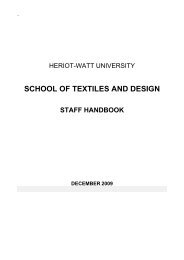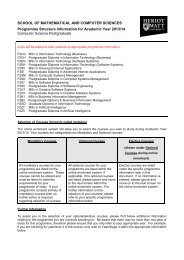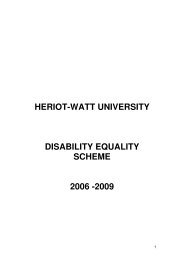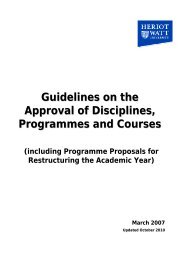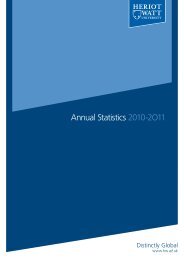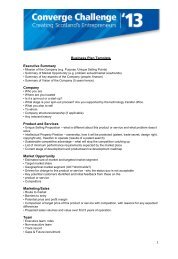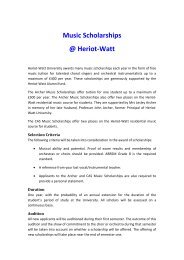ESTATE OFFICE - Heriot-Watt University
ESTATE OFFICE - Heriot-Watt University
ESTATE OFFICE - Heriot-Watt University
You also want an ePaper? Increase the reach of your titles
YUMPU automatically turns print PDFs into web optimized ePapers that Google loves.
<strong>ESTATE</strong> STRATEGY COMMITTEE<br />
ANNUAL REPORT<br />
2003/2004
INTRODUCTION<br />
This report presents information on only the principal activities of the Estate Office for the period 1st<br />
August 2003 to July 31st 2004, it does not cover the area of Health and Safety and Risk Management<br />
which is dealt with in a separate report.<br />
It provides details of the performance of the Estate Office and information on the staffing, turnover,<br />
the main areas of operation and the main projects undertaken during 2003/04. It also provides an<br />
indication of the future strategy and priorities for the Estate Office.<br />
CONTEXT<br />
The Estate Office’s operational area encompasses an extremely wide range of activities principally<br />
including<br />
• Capital Developments (Planning, Buildings, Landscape, Roads, Car Parks, Engineering<br />
Services, Infrastructure etc).<br />
• Maintenance (Buildings, Landscape, Roads, Car Parks, Engineering Services, Infrastructure etc,<br />
both planned and reactive).<br />
• Small Works (Alterations, Extensions, Refurbishment etc).<br />
• Energy (Procurement and Management)<br />
• Administration and Estate Management (Disaster Recovery Planning, Space Management,<br />
Space Audits, Leases, Rates etc)<br />
• Central Support Services (Security, Traffic Management, Waste Disposal, Mail Services,<br />
Transport, etc).<br />
• Research Park Management (Marketing, Development, Leases, Maintenance etc).<br />
• Health and Safety and Risk Management (Preparing Policies, Advising, Auditing, Insurances<br />
etc).<br />
PERFORMANCE AND OUTCOMES<br />
1. Finance<br />
.<br />
a) Turnover<br />
The Estate Office was responsible for a turnover of circa £14.9M during 2003/04. This<br />
represents an increase of 18% over the previous year’s figure of £11.6M.<br />
This marked increase is principally due to the expanded programme of capital<br />
works involved under the SRIF and D.D.A. grants together with the Sports<br />
Academy and MACS Extension projects.<br />
A detailed breakdown of the £14.9M turnover figure is provided in Appendix 1.<br />
b) Recurrent Budget<br />
2
In 2003/04 the Estate Office operated within its allocated budget figure of £5,998K.<br />
At the year end the total expenditure amounted to £5,678, some £320K less then the<br />
budget figure.<br />
The majority of this £320K arose from favourable variances in the area of utilities<br />
2. Performance Indicators<br />
The Report is for 2003-04. Supporting figures are for 2002-03 for the sake of series<br />
consistency (See Appendix 5, P13).<br />
a) At a strategic level the Estate Management Statistics data reveals that: -<br />
(i) For the year 2002/03 <strong>Heriot</strong>-<strong>Watt</strong>’s ratio of total property costs to income was<br />
11%. This compares with the U.K. average of 11%.<br />
(ii) For the year 2002/03 <strong>Heriot</strong>-<strong>Watt</strong>’s ratio of total property costs to expenditure<br />
was also 11%. Again this compares with the U.K average of 11%.<br />
(iii) For the year 2002/03 <strong>Heriot</strong>-<strong>Watt</strong>’s income per square metre net internal area<br />
was £724-04.<br />
This compares with the U.K average of £825-35, the SHEFC Funded<br />
Institutions average of £772-91 and a Peer Group (comprising UMIST,<br />
Universities of Bath, Surrey and Brunel) average of £793-72.<br />
This data confirms that the <strong>University</strong>’s current proportion of spend on property is on<br />
a par with the rest of the sector. However, it also indicates that, as the <strong>University</strong>’s<br />
income per square metre is less than average, then in absolute terms the spend on<br />
property is also less than average.<br />
This merely lends weight to the suggestion that the main “driver” for property spend<br />
is the <strong>University</strong>’s income and therefore the most effective means of securing<br />
additional resources for property is by means of serving to increase income.<br />
b) Operational level performance indicators for the Estate Office are provided in both Appendix<br />
4 and 5.<br />
The Estate Management Statistics data demonstrates that: -<br />
(i) There was a noted increase in the costs of utilities between 2001/02 and<br />
2002/03.<br />
(ii) There was a favourable reduction in the consumption of utilities between<br />
2001/02 and 2002/03 when measured against the peer group.<br />
(iii) Our maintenance costs are well below average and this might be viewed in<br />
isolation as a “positive”. However, given the estimated £21M of backlog<br />
maintenance and compliance issues on the estate, it is suggested that we should<br />
actually be looking to increase the spend on maintenance.<br />
(iv) The Estate Office’s management costs are generally well below average.<br />
(v)<br />
(vi)<br />
The grounds maintenance costs are well below average.<br />
The cleaning costs in 2002/03 are well below average. It should be noted that<br />
changes in the definitions have served to reduce the cleaning costs figures, while<br />
increasing the Facilities Management figures.<br />
c) There has been a noted increase in the level of expenditure on maintenance during<br />
2003/04. Extracting the appropriate figures from the Turnover data in Appendix 1<br />
3
gives the following breakdown of maintenance expenditure.<br />
£K<br />
Long-term maintenance/capital projects: 3,050<br />
Small Works 410<br />
Maintenance Contracts 108<br />
External Contractors 567<br />
Materials 213<br />
Rechargeable Works 1919<br />
Office Overheads 27<br />
Staff 1900<br />
Total £8,194K<br />
This total of £8,144K is a marked improvement over the equivalent figure for 2002/03<br />
of £5,716K. However, although it represents a marked improvement and is a very<br />
substantial investment by the <strong>University</strong>, it must be viewed in the context of an estate with a<br />
total replacement value of circa £200M and with identified backlog maintenance and<br />
compliance issues estimated at £21M, at a time when maintenance cost inflation is running at<br />
5% per annum.<br />
d) Details of progress against the Estate Offices objectives are provided in Appendix 3.<br />
This also contains the mission statement and aims of the Estate Office.<br />
e) Information on Projects and the status of Works in Progress is contained within<br />
Appendix 6.<br />
f) Information on staff levels is contained within Appendix 2.<br />
FUTURE STRATEGY<br />
1) Aims and Objectives<br />
Over the coming year it is intended to work towards establishing clear aims, objectives<br />
and targets for the Estate Office. The intention is to try to develop a rolling 5 year<br />
plan with annual reviews and milestones.<br />
2) Capital Projects, Small Works and Maintenance<br />
These works are all currently prioritised on the basis of: -<br />
(i) Health and Safety.<br />
(ii) Business Continuity/Enhancement.<br />
(iii) Other.<br />
They receive funding approval either direct by P.M.E. or by way of the Small Works<br />
and Maintenance Committee. To date provisional approval has been given to<br />
progressing the following: -<br />
£K<br />
(i) Fire Alarm Upgrades/Renewal 200<br />
(ii) Reinforcement of Petroleum Engineering Substation 121<br />
(iii) Mail Room Re-Location 60<br />
(iv) SEPA Building Defects/Retention 25<br />
4
(v) Refurbishment of Scott Russell Building 430<br />
(vi) Fixed Electrical and Portable Equipment Tests 20<br />
(vii) Fire Risk Assessments Essential Works 50<br />
(viii)<br />
Energy Conservation Monitoring, BMS Expansion and Small<br />
Works 50<br />
(ix) Campus Signage 8<br />
(x) Various Small Works Projects 77<br />
During the course of the year the Estate Office will provide both PME and Small<br />
Works and Maintenance Committee with advice to assist them to determine priorities,<br />
decide and approve further projects, either from within the existing budget allocations<br />
or from new funding opportunities i.e. SHEFC TIF Grants.<br />
3) Quality<br />
In the coming year it is intended that various internal procedures and standing orders<br />
used by the Estate Office will be revised as necessary. The intention is that these<br />
should be developed to fully align with any proposals for enhancing service quality.<br />
Currently work on quality and quality assurance is being taken forward by the<br />
Support Services Board and the Estate Office is keen to adapt and build on this once<br />
the output is available.<br />
4) Utilities<br />
Considerable progress has already been made in reducing the consumption of utilities .<br />
Further proposals and developed business plans will continue to be brought forward to the<br />
Small Works and Maintenance Committee, for projects which require investment to make<br />
further savings.<br />
5) Staffing<br />
As a result of the arrival of the new finance system the Estate Office will be taking<br />
onboard works which were previously dealt with by the Finance Office. As a result a member<br />
of staff from the Finance Office will be transferred to the Estate Office. In addition it is<br />
intended to fill the vacant posts for the Security Officer and Grounds Staff.<br />
As a result of changes in the Warden’s role and pressure on security, a further 6 Security<br />
Patrol Officers will be recruited. They will principally provide a night time security service<br />
and cover for the Residential accommodation.<br />
6) Recurrent Budget<br />
The Estate Office’s budget for 2004/05 has been set at a similar level to the previous year,s<br />
and totals £5,770K. This therefore determines that there is little scope for new initiatives<br />
unless same can be developed from within existing resources. The Estate Office will<br />
therefore be striving both to deliver on initiatives such as providing service level agreements,<br />
while at least maintaining service standards and at least operating within budget.<br />
5
APPENDIX 1<br />
<strong>ESTATE</strong> <strong>OFFICE</strong> ANNUAL REPORT<br />
SUMMARY OF <strong>ESTATE</strong> <strong>OFFICE</strong> TURNOVER<br />
2003/04 2002/03 2001/02<br />
£K £K £K<br />
1 CAPITAL PROJECTS<br />
EBS Kitchen, Classroom, Sports Academy, Infrastructure,<br />
SRIF, DDA, TIF etc. 8,144 4,925 3,955<br />
2 LONG TERM MAINTENANCE PROJECTS 105 24 40 (1)<br />
3 SMALL WORKS 410 290 124 (1)<br />
4 MAINTENANCE CONTRACTS<br />
(Statutory Requirements for Lifts, Legionella etc.) 108 85 79<br />
5 MATERIALS<br />
(Materials for direct labour force on Cleaning, Grounds,<br />
Trades, etc.) 213 285 290<br />
6 EXTERNAL CONTRACTORS/CONSULTANTS<br />
(Glaziers, Builders, Tarmacadam, Planners, Solicitors,<br />
Engineers, Architects, etc.) 567 279 290<br />
7 RECHARGEABLE WORKS -1,919 -700 -573<br />
8 UTILITIES<br />
a) Electricity<br />
b) Gas<br />
c) Water<br />
d) Sewerage<br />
e) Oil<br />
822<br />
769<br />
214<br />
497<br />
6<br />
813<br />
565<br />
210<br />
349<br />
7<br />
934<br />
542<br />
127<br />
210<br />
7<br />
9 RATES/RENT 444 412 397<br />
10 MAIL 144 171 184<br />
11 WASTE DISPOSAL 76 116 133<br />
12 <strong>OFFICE</strong> OVERHEADS 43 42 72<br />
13 OTHER<br />
(Equipment & Equipment Maintenance, Vehicle Costs,<br />
Depreciation, Eye Tests etc.) 781 233 129 (5)<br />
14 STAFF COSTS 2,788 3,063 3,101<br />
15 INSURANCE 652 462 347<br />
Total outturn 14,864 11,631 10,961<br />
Notes:<br />
(1) Whenever appropriate LTM and Small Works are "capitalised" and therefore are included<br />
within the "Capital Projects" total.<br />
(2) The <strong>University</strong> has entered into new contracts for the provision of both gas and electricity<br />
from June 2004 at an increased unit cost of circa 20-37%.<br />
(3) In part the increase between 2002/03 and 2003/04 is due to the commissioning and charging<br />
of in excess of 4 kilometres of new gas pipework.<br />
(4) The large increase is mainly due to leaks and to changes in legislation. In the year 2001/02<br />
the <strong>University</strong> was not charged for water and sewerage services to Residences. However this<br />
"loophole" was closed and in 2002/03 the <strong>University</strong> had to pay for these services. Major<br />
changes to the tariffs impacted on the 2003/04 figures.<br />
(5) A number of significant items of equipment were replaced during 2002/03 (e.g. JCB) and the<br />
marked increase in 2003/04 is due to the way depreciation is now being dealt with.<br />
(2)<br />
(3)<br />
(4)<br />
(4)<br />
6
APPENDIX 2<br />
<strong>ESTATE</strong> <strong>OFFICE</strong> STAFFING<br />
2003/04 2002/03 2001/02<br />
Director 1 1 1<br />
Assistant Directors 2 2 2<br />
Fabric Officer 1 1 1<br />
Security Officer - 1 1 The Security post is currently being<br />
advertised.<br />
Research Park Manager 1 1 1<br />
Energy/Environmental Officer 1 1<br />
Trades Staff 31 31 31<br />
Cleaning Staff - 58 61 All cleaning staff were transferred to Catering<br />
& Residences in 2003-04.<br />
Landscape Staff 16 17.5 17.5 Staff numbers were reduced while the sports<br />
fields were being refurbished as part of the<br />
Sports Academy project. Staff are currently<br />
being recruited to make up the complement<br />
now that the sports fields are complete.<br />
Mail Staff 7 7 7<br />
Drivers 3 3 3<br />
Health & Safety 3 3 3<br />
S.P.O.s 34 34 34<br />
Admin/Clerical/Secretarial 4.5 4.5 4.5<br />
TOTAL 103.5 165 167<br />
7
APPENDIX 3<br />
<strong>ESTATE</strong> & BUILDING SERVICES <strong>OFFICE</strong> MISSION STATEMENT<br />
To provide, maintain and develop and safe and high quality environment, in a professional efficient<br />
and cost effective manner to enable the <strong>University</strong> to fulfil its mission.<br />
Overall Aims and Objectives (These are all as stated in previous Annual Reports)<br />
a) The Aims<br />
i) To provide the <strong>University</strong> with appropriate professional advice to allow both the<br />
maximum benefits to be obtained from the Estate resources and to achieve the<br />
<strong>University</strong>’s Strategic Objectives.<br />
ii)<br />
iii)<br />
iv)<br />
To prudently and professionally develop and maintain the Estate at standards and<br />
within timescales and costs to meet the requirements of the <strong>University</strong>.<br />
To introduce, maintain and review systems of work within the Estate Office in line<br />
with “best practice” to improve performance, value for money, customer satisfaction,<br />
staff morale and knowledge base.<br />
To maximise the potential benefits from the Research Park through its continued<br />
development, the recruitment of new tenants and the maintenance of good working<br />
relationships with existing tenants.<br />
v) To facilitate a change in the environment of health and safety throughout the<br />
<strong>University</strong> from one of reluctant compliance with minimum requirement to one of<br />
striving to achieve the benefits of best practice by the participation of all staff and<br />
students.<br />
b) The Objectives (and notes on progress)<br />
i) To refine and further develop the procedures necessary to provide for a rolling<br />
programme to review the staffing, structure and resources required to ensure the<br />
provision of an efficient and cost-effective operation with appropriate User/Customer<br />
feedback checks.<br />
On an annual basis all Heads of Section now prepare and submit their staffing and<br />
budgetary requirements. This forms the basis of the submission which is made for the<br />
entire Estates Office. In addition through the medium of the regular meetings of<br />
Heads of Sections, they can highlight changes in both demand and circumstance<br />
which have an impact on both their staff and budget requirements. If these cannot be<br />
satisfactorily addressed from within the existing Estate Office resources, a case is<br />
then prepared and presented to the senior management of the <strong>University</strong> (P.M.E) for<br />
consideration.<br />
The Estate and Building Services Office has already sought customer feedback on one<br />
occasion through the distribution of questionnaires. However, it is intended<br />
(resources permitting) to refine this exercise to incorporate parts of the "HEFCE<br />
Guidance on Procurement Benchmarking" and then repeat the exercise.<br />
8
ii)<br />
To introduce and develop job costing/stock control<br />
The resources required to provide a complete job costing/stock control system have<br />
not been made available. However, in conjunction with the Supplies Office of the<br />
<strong>University</strong> a stock control system has been developed using their existing software<br />
system and is now in use. It's intended to build on this to develop a job costing<br />
facility, if possible linking into the new finance system.<br />
iii)<br />
To develop and introduce performance indicators<br />
Performance indicators have already been introduced (see separate section of the<br />
report). However, work is continuing to both establish other useful metrics plus to<br />
refine the existing.<br />
iv)<br />
To improve communications both internal and external<br />
Communications within the Estate and Building Services Office have been improved<br />
through the regular meetings of Heads of Sections. Regular meetings are held with<br />
customer representatives and the Director attends the meetings of the Principal's<br />
Advisory Group and Support Services Board.<br />
v) To develop and introduce Service Level Agreements<br />
A Service Level Agreement is now in place to cover the provision of a stock control<br />
service by the Supplies Office for the Estates and Building Services Office. A further<br />
Service Level Agreement has been put in place to cover the grounds maintenance for<br />
the Sports Academy.<br />
vi)<br />
To develop and establish a Help Desk<br />
The resources required to progress this have not been made available.<br />
vii)<br />
To improve Space Utilisation/Monitoring<br />
Space surveys of Centrally Timetabled Spaces have been carried out in previous<br />
years and it is still intended that these will be expanded to cover additional areas if<br />
resources permit.<br />
viii)<br />
To monitor costs for each property/department<br />
The resources required to install individual meters throughout have not been made<br />
available. However, a substantial number of additional meters have been installed as<br />
funding has permitted. In addition further work is being taken forward as a result of<br />
the “Full Economic Costing” initiative.<br />
ix)<br />
To carry out Condition Surveys and review the Long Term Maintenance Plan<br />
The full surveys were last carried out in 1999 and a Long Term Maintenance Plan is<br />
prepared annually based on the survey reports, updates and taking cognisance of<br />
other priorities. This information is fed into the LTM/Small Works Committee to<br />
assist in establishing funding priorities.<br />
x) To have early input to Strategic Planning<br />
9
The Director's membership of P.A.G. has assisted this as has the work on both the<br />
Estate Strategy Review <strong>University</strong> Masterplan and Research Park Masterplan.<br />
xi)<br />
To complete Estate Strategy Review<br />
This is complete.<br />
xii)<br />
To complete 25 years forward planning “blueprint”<br />
The <strong>University</strong>’s Masterplan for the Edinburgh Campus at Riccarton is complete.<br />
The Masterplan has been adopted as supplementary planning guidance under the<br />
Rural West Edinburgh District Plan. However, in addition an application for formal<br />
outline planning consent has been lodged for the Masterplan.<br />
xiii)<br />
To complete and satisfy objectives of the current Strategic Plan<br />
This is ongoing.<br />
10
APPENDIX 4<br />
PERFORMANCE INDICATORS<br />
In accord with the prescribed format the performance indicators for the year 2003/2004 are as<br />
follows:-<br />
1. Conforming with legislation by :-<br />
• Provision of policy documents to confirm with legislation where appropriate<br />
Suitable bespoke documentation is either in place or standard “Approved Codes of<br />
Practice” are applied<br />
• Monitoring compliance with legislation<br />
The <strong>University</strong> has not received any “Improvement Notice” during 2003/04 from either the<br />
HSE or any other Regulatory body.<br />
2. Completion of major build projects on time and within budget<br />
All were completed on time and within budget except where otherwise detailed<br />
elsewhere within the report.<br />
3. Completion of LTM and minor works projects on time and within budget.<br />
All projects were completed on time and within budget.<br />
4. Monitoring performance against <strong>University</strong> Strategy and Estate Strategy<br />
It is currently difficult to measure performance against the general aims as set out in the<br />
current <strong>University</strong> and Estate Strategies. However, as and when these aims have been<br />
converted and clarified as S.M.A.R.T. objectives (i.e. specific, measurable, achievable,<br />
realistic and timed) then these have all been met.<br />
5. Condition of Buildings<br />
The condition and compliance report of 1999 identified a requirement for £19M of<br />
investment to bring the entire estate up to standard. Applying tender price inflation to this<br />
figure to bring it up to date provides a figure of over circa £23M. Over the same 5-year<br />
period the condition of the estate will have continued to decline through “wear and tear”<br />
while there’s also been a number of new compliance issues brought into place (Disability<br />
Discrimination Act, Fire Risk Assessments etc). Together these two factors serve to further<br />
inflate the £23M figure. However, against this over the same 5-year period, monies have<br />
been invested in long-term maintenance and capital works. Accordingly, it is estimated that<br />
the current investment requirement to bring the entire estate up to standard will be not less<br />
than £21M.<br />
6. Functional suitability of Buildings/Estate<br />
11
As part of the Estate Strategy Revision a functional suitability assessment was undertaken<br />
which revealed that 10% of the total floorspace was rated good, some 65% was rated<br />
satisfactory a with a further 25% rated fair.<br />
7. Space Utilisation<br />
Space audits in 2000/01 revealed a space utilisation rate for centrally controlled space of<br />
34%. However, there have been no further audits carried out since.<br />
8. Comparison with other appropriate institutions on:<br />
• energy costs per square metre gross internal area<br />
• energy costs per 100 kW/h consumption<br />
• energy consumption kW/h per square metre gross internal area<br />
• water/sewage costs per square metre gross internal area<br />
• water/sewerage costs per m³<br />
• water consumption m³ per square metre gross internal area<br />
• maintenance costs per square metre gross internal area<br />
• estate management costs per square metre net internal area<br />
• property management costs per square metre net internal area<br />
• facilities management costs per square metre net internal area<br />
• project management costs per square metre net internal area<br />
• ground maintenance costs/grounds area<br />
• cleaning costs per square metre net internal area<br />
* Refer to Appendix 5 - Estate Management Statistics<br />
9. Performance of Research Park against budget/targets<br />
The Research Park met its targets within budget<br />
10. Benchmarking<br />
• Which area identified and with which organisation<br />
• Progress made in areas identified<br />
* Refer to Appendix 5 - Estate Management Statistics<br />
12
APPENDIX 5<br />
<strong>ESTATE</strong> MANAGEMENT STATISTICS<br />
The EMS project was established by the joint UK Funding Councils and has used a team of<br />
consultants to determine key performance indictors for estates and to develop and refine definitions<br />
for these indicators such as to permit inter Higher Education Institution (HEI) comparisons to be made<br />
on as fair a basis as possible.<br />
The data used in the project is sourced from the Higher Education Statistics Authority (HESA), the<br />
<strong>University</strong>'s Finance Office, Human Resources, Catering and Residences Office in addition to the<br />
Estate Office.<br />
Currently data has been collated and reports provided covering five years (98/99, 99/00, 00/01, 01/02,<br />
02/03). These reports provide a wealth of data on the estate. However, due to fundamental changes<br />
to the definitions during the first years it is not appropriate to use the early years in timeseries data to<br />
try to determine trends. However, for the purpose of this report and in order to address the key points<br />
in item 8 of Appendix 4, data has been extracted from the most recent report (02/03) to provide<br />
comparative information on <strong>Heriot</strong>-<strong>Watt</strong> <strong>University</strong>'s entire estate (non-residential and residential) on<br />
each issue against the average for:<br />
(a)<br />
(b)<br />
(c)<br />
All UK HEIs<br />
All SHEFC Funded HEIs<br />
A Peer Group of Universities comprising UMIST, the Universities of Bath, Surrey and<br />
Brunel.<br />
The following table shows <strong>Heriot</strong>-<strong>Watt</strong>'s position (expressed as a percentage of the mean) for each<br />
measure compared against all UK Higher Education Institutions, all SHEFC Funded Institutions and<br />
against the Peer Group (UMIST, Universities of Bath, Brunel and Surrey).<br />
13
The table provides details of <strong>Heriot</strong>-<strong>Watt</strong>’s position in 2002/03 expressed as a percentage of the mean.<br />
The figures in brackets are those for the previous year 2001/02. Both are shown compared against all<br />
UK Higher Education Institution’s, all SHEFC Funded Institutions and against a Peer Group<br />
comprised UMIST, Universities of Bath, Surrey and Brunel.<br />
Measure UK HEIs SHEFC Peer Group<br />
Energy costs per square metre<br />
gross internal area<br />
(117%)<br />
115%<br />
(117%) 110% (116%) 110%<br />
Energy costs per 100kw/h<br />
consumption<br />
(86%) 80% (90%) 88% (100%) 112%<br />
Energy consumption kw/h per<br />
square metre gross internal area<br />
Water/Sewerage costs per square<br />
metre gross internal area<br />
(133%)<br />
138%<br />
(139%)<br />
234%<br />
(127%) 123% (114%) 93%<br />
(121%) 167% (109%) 162%<br />
Water/Sewerage costs per m³<br />
consumption<br />
(65%) 88% (47%) 65% (84%) 134%<br />
Water consumption m³ per<br />
square metre gross internal area<br />
(188%)<br />
240%<br />
(189%) 207% (127%) 126%<br />
Maintenance costs per square<br />
metre gross internal area<br />
Estate Management costs per<br />
square metre net internal area<br />
Property Management costs per<br />
square metre net internal area<br />
Facilities Management costs per<br />
square metre net internal area<br />
Project Management costs per<br />
square metre net internal area<br />
Grounds Maintenance<br />
costs/grounds area<br />
Cleaning costs per square metre<br />
net internal area<br />
(67%) 75% (89%) 96% (53%) 52%<br />
(32%) 60% (28%) 53% (42%) 64%<br />
(24%) 31% (23%) 37% (42%) 73%<br />
(21%) 23% (54%) 44% (68%) 125%<br />
(18%) 15% (15%) 17% (36%) 44%<br />
(52%) 71% (72%) 92% (41%) 56%<br />
(114%)<br />
53%<br />
(140%) 62% (124%) 58%<br />
As from 1 August 2003<br />
responsibility for<br />
cleaning transferred to<br />
Catering and<br />
Residences.<br />
14
APPENDIX 6<br />
Projects and Works in Progress<br />
1) MacLaurin Building<br />
The extension to the Mountbatten Building, which is to enable staff in the School of<br />
Mathematics and Computer Science to be collocated, started on site in February 2004. The<br />
building is of modular construction and is connected to the Mountbatten Building by a 4<br />
storey link block. The accommodation comprises mainly staff offices but in addition there are<br />
3 teaching rooms, social space and toilets/showers.<br />
The original contract completion date was 31 st July 2004 with occupation by staff and<br />
students in October 2004. The initial stages of the contract went well, notably the ground<br />
works and the delivery of the modules to site. Problems arose however, when the Contractor,<br />
Yorkon Ltd, was asked to produce details of construction of the brickwork cladding. Plans<br />
were submitted for verification to Ove Arup, Structural Consultants who raised serious<br />
concerns about aspects of the design, especially the movement of the brickwork and the<br />
possibility of cracking.<br />
It emerged that while the Contractor had previously provided brick cladding on 3 storey<br />
buildings, this was the first 4 storey building the firm had undertaken. The resolution to the<br />
design problems took several months to achieve and final agreement on the design was only<br />
reached in August 2004.<br />
The consequence of this is that the original contract completion date could not be met. The<br />
revised completion date is 18 th October 2004 but this depends on the brickwork being<br />
completed in line with the revised programme and this in turn is now weather dependant. The<br />
new occupation date for staff and students is December 2004.<br />
The project budget is £3.3m with approximately £2.0m being funded from the SRIF 1 and 2<br />
programmes and £500K from the MacMillan Trust.<br />
2) Sports Academy<br />
The Sports Academy was completed in 28 th March 2004 and was formally opened by Andy<br />
Roxburgh, Technical Director, UEFA on 3 rd May 2004. The contract was completed by HBG<br />
following the demise of the original Contractor, Melville Dundas Ltd. The accommodation<br />
provides dedicated changing and office facilities for Heart of Midlothian Football Club,<br />
laboratories for Sports Science teaching, treatment rooms and an indoor pitch .<br />
To the south of the Academy building lie the competition grass pitch and an all weather pitch<br />
both of which are floodlit. A further 5 pitches were refurbished.<br />
Following a competitive tendering exercise the contract for pitch maintenance has been won<br />
by the in-house Landscape Section. A qualified groundsman has been recruited to augment<br />
the existing grounds staff to ensure the standard of pitches would be maintained.<br />
The final account has still to be agreed but it is anticipated that the project will finish at £6.2<br />
million compared to the original budget of £6.05 million.<br />
15
3) Scientific Research Infrastructure Funds (SRIF)<br />
(a) Phase 1<br />
• School of Management and Languages:<br />
Management and European Studies Research Unit.<br />
• School of Engineering and Physical Sciences:<br />
Biomimetics.<br />
• School of Engineering and Physical Sciences:<br />
Photonics.<br />
The programme of building works has been completed and all the final accounts settled. Each<br />
of the three projects finished within the SRIF budgets set.<br />
Phase 2<br />
Institute of Petroleum Engineering: Refurbishment of Research Building 1.<br />
Research Building 1 is to be extensively refurbished to accommodate high performance<br />
computer equipment which is available to the whole of the <strong>University</strong> as well as Petroleum<br />
Engineering. The refurbishment includes replacing roof and wall cladding and remodelling<br />
the inside of the building. The focal point of the building will be a large computer room with<br />
attendant server room. The remainder of the building will be office space and in the future it<br />
is planned to create seminar rooms when funding is available.<br />
To expedite the main contract an advance demolition contract was let and this work was<br />
completed in April 2004. Tenders for the construction work were submitted in June 2004 and<br />
a contract is due to be let shortly. A site start is programmed for 4 th October 2004 with<br />
completion in 29 th April 2005.<br />
The total project budget including professional fees and VAT is £900K.<br />
b) School of the Built Environment:<br />
William Arrol and Edwin Chadwick Buildings.<br />
Redundant laboratory space was refurbished to provide computer areas for post-graduate<br />
students as well as improved facilities in two laboratories. In addition a new fire detection<br />
system was installed in the William Arrol building. Work commenced in 19 th April 2004 and<br />
was completed on 9 th July 2004.<br />
The total project budget including professional fees and VAT is £323K.<br />
c) School of Engineering and Physical Sciences:<br />
Perkin Building.<br />
The refurbishment programme which began under SRIF 1 is to continue with the upgrading<br />
of several more research laboratories and the provision of computing facilities. Plans have<br />
been drawn up and agreed with the Users. These have been costed and after some<br />
modifications are now within the SRIF 2 budget of £680K.<br />
Detailed design including the submission for building warrant is proceeding and tenders will<br />
be sought in the October/November 2004.<br />
16
d) Nasmyth Building 1.<br />
Plans have been drawn up for the refurbishment of several laboratory areas on the ground<br />
floor of the Nasmyth Building which are to be occupied by the Manufacturing Research<br />
Group. The total SRIF 2 budget for the work is £320K.<br />
Detailed design including the submission for building warrant is proceeding and tenders will<br />
be sought in October/November 2004.<br />
e) Coulson Building.<br />
Laboratory space now deemed no longer fit for purpose was to be reconfigured to provide<br />
facilities for current research programmes, including bio-manufacturing processes. This<br />
requires a feasibility study to be undertaken, and because of the complexity of the building<br />
this will take some time to complete. In the meantime the opportunity arose to convert 3<br />
laboratories on the first floor of the Nasmyth Building instead for bio-manufacturing research.<br />
Plans and costs are currently being drawn up in conjunction with the User.<br />
The total budget available for the Coulson project is £850K from which the cost of the work<br />
in the Nasmyth Building will be met.<br />
4) Scott Russell Building<br />
When the building is vacated by MACS staff and students it is planned to implement a phased<br />
programme of refurbishment work. Scott Russell was one of the earliest academic buildings<br />
to be completed (1973) and requires upgrading to meet current legislation.<br />
In Phase 1 the first and third floors will be refurbished to accommodate Careers and TRS.<br />
This includes rewiring, new lighting, data provision, redecoration an upgrading of the toilets,<br />
fire alarms and emergency lighting. In addition on the top floor some building alteration work<br />
will be carried out to form a new classroom with an occupancy of 80.<br />
Future phases will include similar work on ground and second floors as well as the<br />
reconfiguration and refurbishment of the computer laboratories on the ground floor.<br />
Design work is in progress but work cannot begin in the building until early 2005.<br />
5) Edinburgh Business School<br />
Kitchen/Dining Extension.<br />
The contract was completed in August 2003 but outstanding snagging items remained. The<br />
Architect went into receivership and so the Estate Office has been pursuing these. Some<br />
snagging items still remain outstanding but one of the most serious has now been dealt with.<br />
The condition of the floor covering in the kitchen was deemed unacceptable but the<br />
Contractor refused to replace it maintaining it could be rectified. After obtaining independent<br />
advice, it was decided to withhold money from the Contractor and renew the floor covering.<br />
This involved stripping out all the kitchen equipment. The Business School identified a two<br />
week period when the kitchen could shut down to allow this to happen. The work was<br />
completed in August 2004.<br />
17
Roof.<br />
The final remedial work to the atrium glazing, which has been outstanding for two years,<br />
could not be carried out until the kitchen contract was completed. Also it became clear that<br />
for safety reasons the atrium, and particularly the kitchen, could not be in operation while<br />
men were working on the glazing. It was decided therefore to co-ordinate this work with<br />
renewing the floor covering in the kitchen when the latter would have to be closed.<br />
The remedial work which involved renewing all the seals in the glazing was completed on<br />
25 th August 2004. The Contractor encountered great difficulties because of the exceptionally<br />
inclement weather and was forced to erect a tent structure above the atrium to continue<br />
working because of the deadline imposed by the Users to have the work completed.<br />
Mowlem have now requested that the balance of retention monies (withheld by the <strong>University</strong><br />
until the work was completed) should now be released. The sum involved is £44,817 (incl.<br />
VAT).<br />
6) Residences 6 Lord Home Hall<br />
The project was completed in 1999. However, there have been persistent problems with the<br />
windows. The Contractor (Millers) has made several attempts to repair the windows but with<br />
no success. A legal action is now being raised against the Contractor to sue for the<br />
replacement of all the windows.<br />
7) Long Term Maintenance / Small Works<br />
During the year the LTM / Small Works Committee allocated funds for a number of<br />
projects, the main ones being:-<br />
Small Works (Total Expenditure £409,999)<br />
(i)<br />
(ii)<br />
(iii)<br />
(iv)<br />
(v)<br />
(vi)<br />
(vii)<br />
(viii)<br />
(ix)<br />
(x)<br />
(xi)<br />
(xii)<br />
(xiii)<br />
(xiv)<br />
Upgrading main entrance to David Brewster Building.<br />
Chaplaincy – redecoration / emergency lighting / new fire alarm system.<br />
Finance Office – installation of CCTV.<br />
Computer Centre Seminar Room – installation of sensible cooling.<br />
Braking system for Wood Workshop.<br />
Speed bumps.<br />
Mountbatten Building – installation of sensible cooling.<br />
William Perkin Building – sealing of windows.<br />
Library Server Room – back-up power.<br />
Erection of fire wall – William Arrol Building.<br />
Muslim Prayer Room – Hugh Nisbet Building.<br />
Recycling Centre set up.<br />
Review of signage strategy.<br />
Upgrade of fire alarm system, SBC.<br />
LTM (Total Expenditure £108,432)<br />
(i)<br />
(ii)<br />
(iii)<br />
(iv)<br />
(v)<br />
Asbestos removal - various locations.<br />
Water services repairs.<br />
Gas man repairs.<br />
Gas soundness testing of buildings.<br />
Replacement of cooling tower - David Brewster Building.<br />
18
(vi)<br />
Condition survey of Hermiston House roof.<br />
8) DDA Grant<br />
The <strong>University</strong> received a grant of £406,000 for work associated with bringing its<br />
estate up to the standards required to meet the new DDA Act. This has been spent on<br />
a number of projects of which the major ones are listed below:-<br />
(i)<br />
(ii)<br />
(iii)<br />
(iv)<br />
(v)<br />
(vi)<br />
(vii)<br />
(viii)<br />
(ix)<br />
Petroleum Engineering, Conoco Building – installation of disabled lift.<br />
Estate Office – installation of disabled lift.<br />
Sports Village – installation of lift / disabled toilets.<br />
Library – installation of disabled lift.<br />
Lecture Theatres – ramps.<br />
Archives – disabled ramps.<br />
School of Management – new floor covering.<br />
SBC, High Mill – disabled toilet / screens.<br />
SBC – corridor doors.<br />
9) Energy / Environmental Works<br />
This year saw the Energy/Environmental Officer post being made into a permanent<br />
position. Projects which have been pursued this year include:-<br />
(i) Replacement of boilers, U3.<br />
(ii) Extension of BMS system to all major plant rooms.<br />
(iii) Upgrading of all gas governor stations.<br />
(iv) Installation of sensible cooling.<br />
(v) Further development of recycling systems.<br />
(vi) Major rebalance / upgrade of U3 Academic 1, heating system.<br />
10) Replacement of Medium Pressure Gas Network<br />
Following the HSE Improvement Notice served on the <strong>University</strong> to replace all its medium<br />
pressure ductile metal gas pipework the <strong>University</strong> compressed its replacement programme<br />
into a single year. A contract was awarded to ERDC in April 2004 at an estimated total cost<br />
of £620,000 to replace 2.8 kilometres of gas pipe running through the heart of the Campus.<br />
This major infrastructure upgrade has been undertaken during the summer and will be<br />
completed by 27 September 2004, well before the December 2004 deadline issued by the<br />
HSE.<br />
The contract will come in on budget despite its complexity and has been undertaken with the<br />
minimum impact on the campus buildings despite the volume of work.<br />
11) Utilities and Waste<br />
This year has seen the renewal of both our gas and electricity contracts. With the rise in oil<br />
prices worldwide there has been a noticeable rise in all utilities that depend on oil or that are<br />
related to the production of oil.<br />
19
The electricity contract was tendered in March 2004 with a resultant rise in supply costs to the<br />
<strong>University</strong> of c37%. This converts to an increase in cost for electricity from £821,900 to<br />
£1,126,000 of which 4.25% is rechargeable to Research Park companies.<br />
The gas contract was tendered in June 2004 with a resultant rise in supply costs to the<br />
<strong>University</strong> of c20%. This converts to an increase in cost for gas from £769,048 to £922,850<br />
of which 30% is rechargeable to Research Park companies.<br />
There is no competition currently in the Water/Sewerage industry. This year the <strong>University</strong><br />
has entered into a new 3 year supply/disposal contract with Scottish Water. As a large<br />
volume user the <strong>University</strong> receives a discount on the tariff it is given. Even so, the cost of<br />
water has risen by c2% whilst the sewerage has risen by 46% partly due to surface charges<br />
which we previously did not get.<br />
Recycling is now well established on the <strong>University</strong>. With the introduction of waste<br />
containers and the segregation of waste there has been a noticeable reduction in the number of<br />
waste uplifts from site. Cardboard and paper recycling has been a great success due to the<br />
efforts of the General Labourers. An incentive scheme to reward their effort is currently with<br />
senior management for approval.<br />
The Energy/Environmental Officer is working with Residence Managers to increase the<br />
amount of recycling that can be carried out by students in residences. It is hoped that this will<br />
further increase the <strong>University</strong>'s recycling capacity over the coming year.<br />
Since last year the cost of waste removal has reduced from £116,000 to £76,000.<br />
12) Clearwater House Extension (Formerly Known as the SEPA Building) Research Park<br />
This project suffered some delays and was not completed until December 2001. The project<br />
cost was within the budget of £1.95M. However, the Contractor failed to honour his<br />
obligation to attend to defects and after protracted legal disputes these are now being<br />
addressed by others with the costs being deducted from the monies due to the Contractor.<br />
The building was sold in the autumn of 2002. However, under the terms of the sale the<br />
<strong>University</strong> is obliged to finalise the Extension works.<br />
13) Security<br />
The number and type of incidents dealt with by the Security Patrol Officers (SPO’s) has<br />
remained fairly constant with those reported in previous years. However, it’s understood that<br />
there has been a marked increase over previous years in the number of security problems dealt<br />
with by the Wardens within the Residences. This has resulted in the <strong>University</strong> altering the<br />
role of Wardens and providing additional SPO’s to cover the Residences throughout the night<br />
during term time.<br />
14) Mail<br />
There has been a slight reduction in the quantity of outgoing mail. However, this has been<br />
more than offset by the continued growth of mail received.<br />
20
15) Planning<br />
The Masterplan for the Edinburgh campus had previously been formally agreed with the<br />
Local Authority and adopted as supplementary planning guidance. An outline planning<br />
application has been lodged for the Masterplan. On receipt this should greatly assist the<br />
<strong>University</strong> in achieving its strategic objectives as regards the estate.<br />
The Estate Office has been assisting SISTech in the development of the Green Travel Plan<br />
required by the Local Authority.<br />
The Estate Office is also involved in and providing advice for, the current discussions with<br />
Borders College in respect of exploring opportunities for the development of the Scottish<br />
Borders campus.<br />
16) Research Park<br />
<strong>Heriot</strong> –<strong>Watt</strong> Research Park is one of seven member Science/Research Parks in the Edinburgh<br />
area which have joined under the umbrella of the Edinburgh Science Triangle (EST). The<br />
EST will be used as a marketing vehicle to increase the awareness worldwide of East Central<br />
Scotland as a location for Science, Research & Development. The Launch will take place at<br />
Pentland Science Park hosted by The Principal of <strong>Heriot</strong>-<strong>Watt</strong>, Professor John Archer. Jim<br />
Wallace, Scotland’s Deputy First Minister, will officially Launch the EST at 9.00 Hrs on the<br />
30 th September 2004.<br />
The Infrastructure works for the next expansion phase of the Research Park, which is the first<br />
of a planned three phases, has now been completed. The funding for this has been provided<br />
by Scottish Enterprise Edinburgh & Lothian (SEE&L) which will be paid back by the<br />
<strong>University</strong> through the sharing of income from Leasing of the serviced sites provided.<br />
A Joint Venture Partner (JV), has still to be secured by SEE&L the preferred bidder did not<br />
pursue their interests and although this proved disappointing it has allowed both the<br />
<strong>University</strong> and SEE&L to re-assess what their joint plans are for the development of the<br />
Research Park. When the JV is appointed it will provide a more proactive and responsive<br />
vehicle for the sustained development of the Research Park.<br />
This year has seen the completion of the premises for the Institute of Occupational Medicine<br />
(IOM). The building was officially opened by Jim Wallace, Scotland’s Deputy First<br />
Minister, in early summer. IOM work in close collaboration with The School of The Built<br />
Environment and with this relocation the options for further partnerships in the future are<br />
greatly enhanced.<br />
The site between Renishaw and Mentor Biopolymers is to be developed by a Jersey based,<br />
Scottish owned, Company. The Lease negotiations for this are at an advanced stage and the<br />
turf is due to be cut on phase 1 of this project in October 2004.<br />
The building previously occupied by Edinburgh Instruments, for in excess of 25 years, is<br />
being refurbished to allow the continued occupation by Environment Research Technology, a<br />
spin out from the Institute of Offshore Engineering. Edinburgh Instruments have now<br />
completed their move to Livingston where they are now co-located with their sister company<br />
Edinburgh Sensors<br />
A-Life was acquired by a large American group, Mentor, and is now Mentor Biopolymers.<br />
Edinburgh Petroleum Services was acquired by an American Company but continue under<br />
21
their very successful name on the Research Park. The remainder of the Research Park has<br />
remained remarkably stable.<br />
Enquiries for space on the Research Park are increasing again prompted by the activity seen<br />
when the new extension infrastructure was completed and by the increased interest generated<br />
by the news of the expected new development due to start in October 2004.<br />
22



